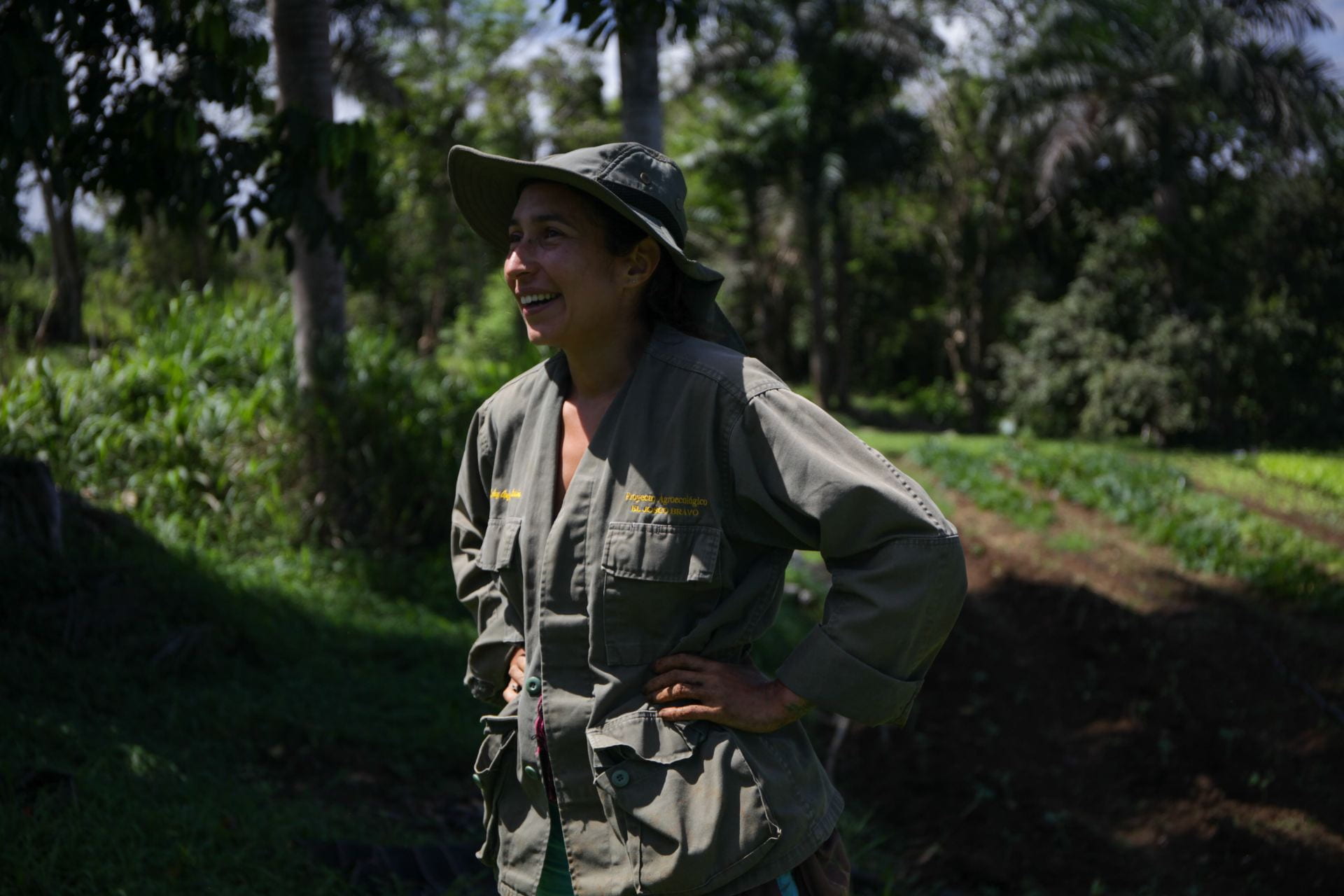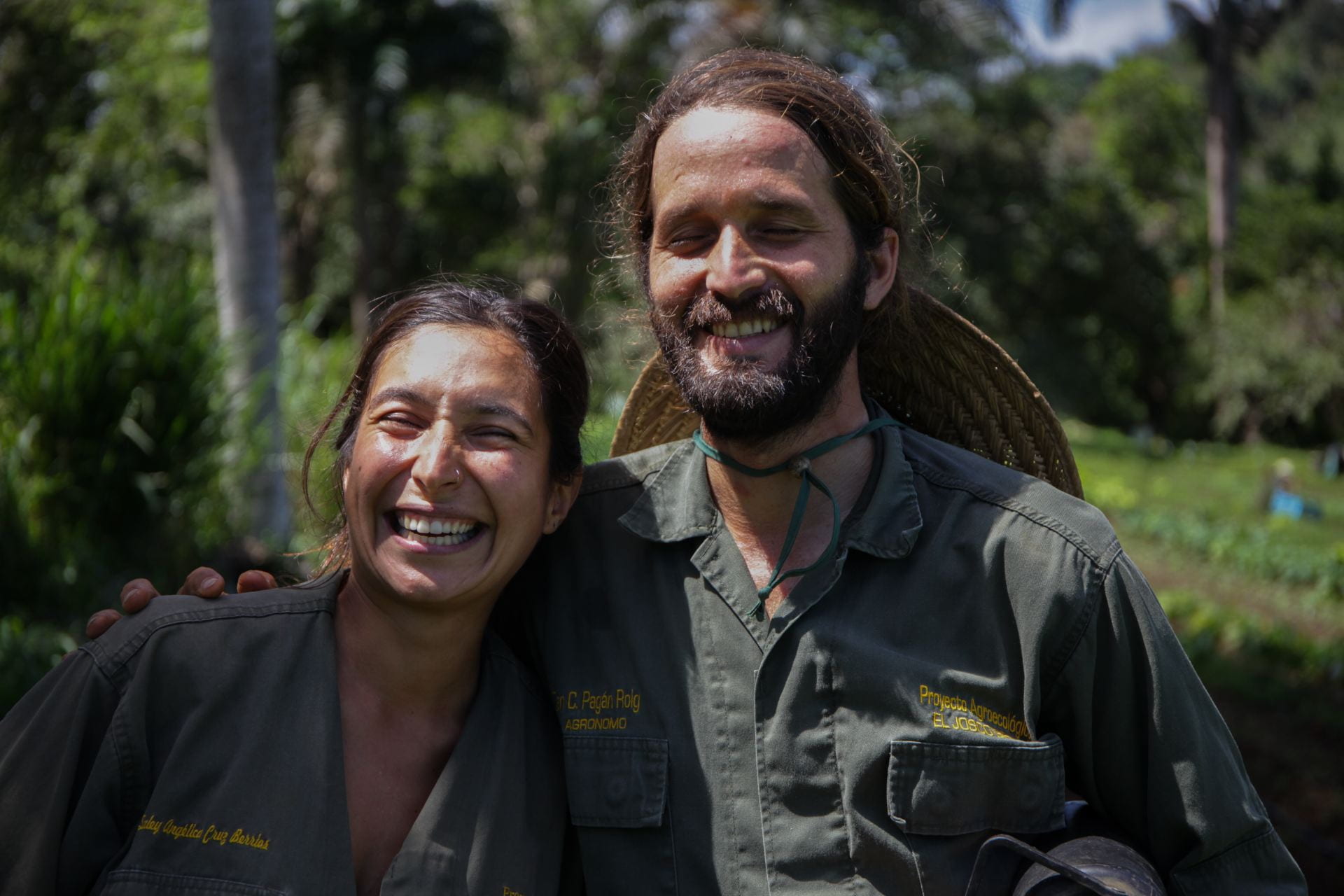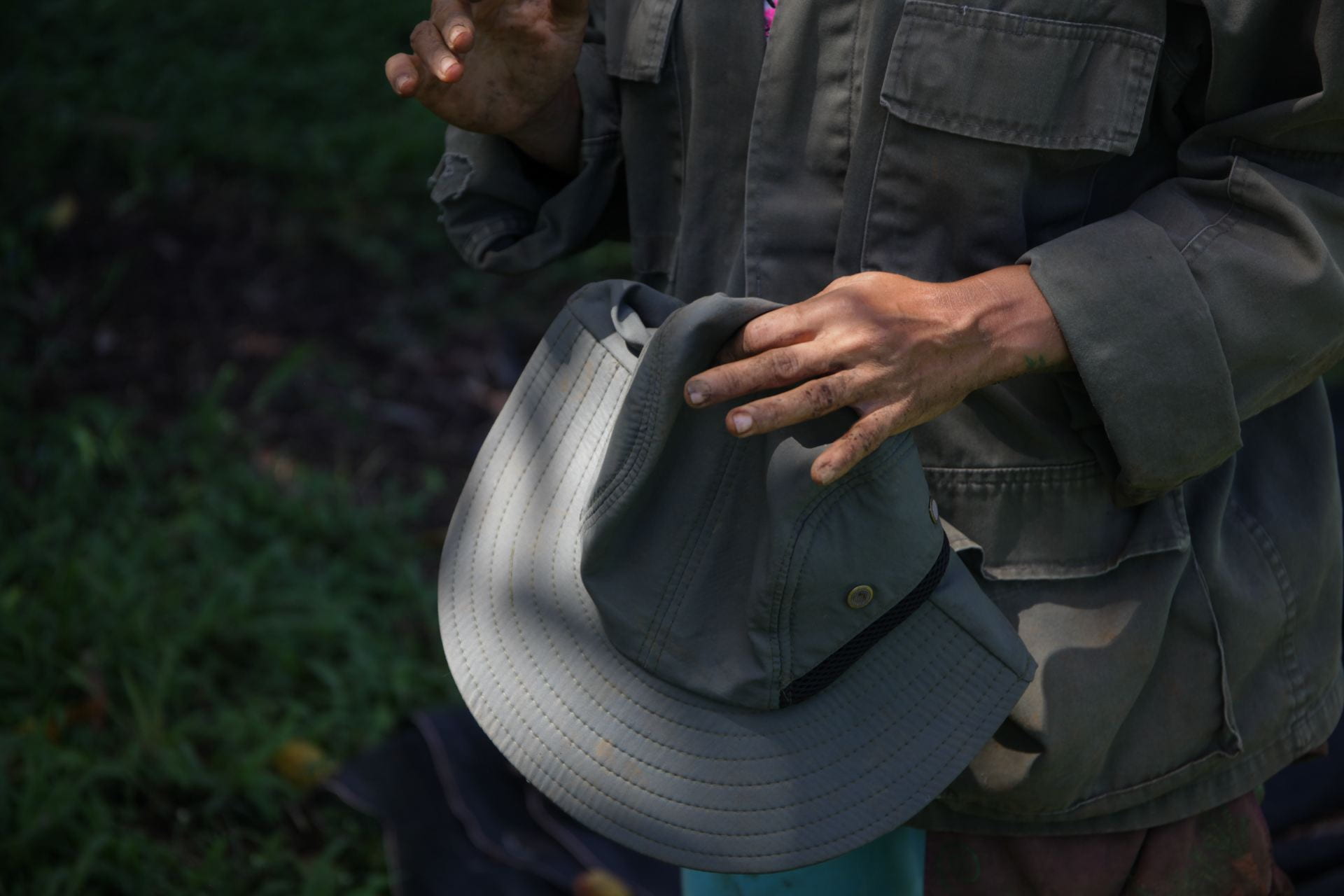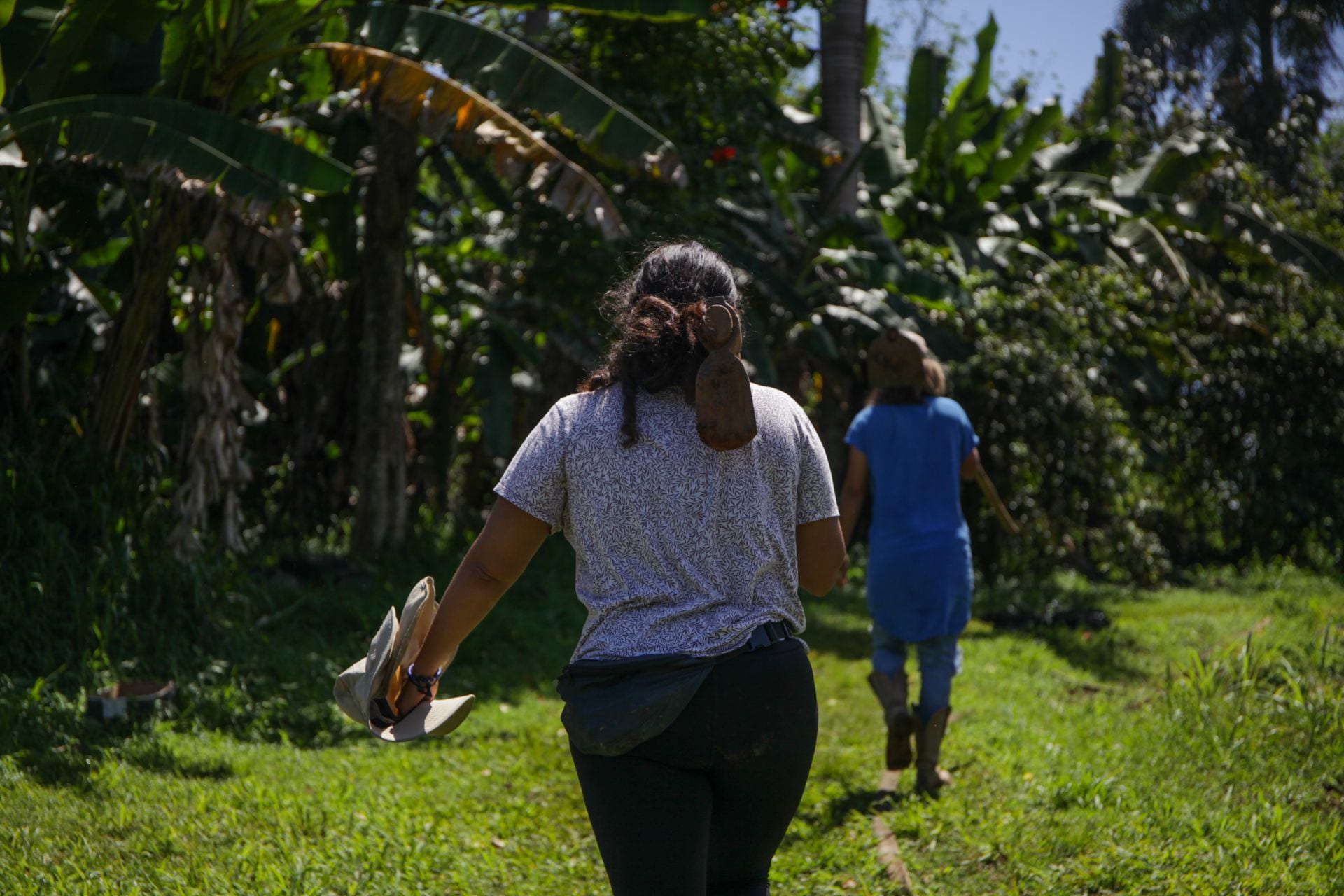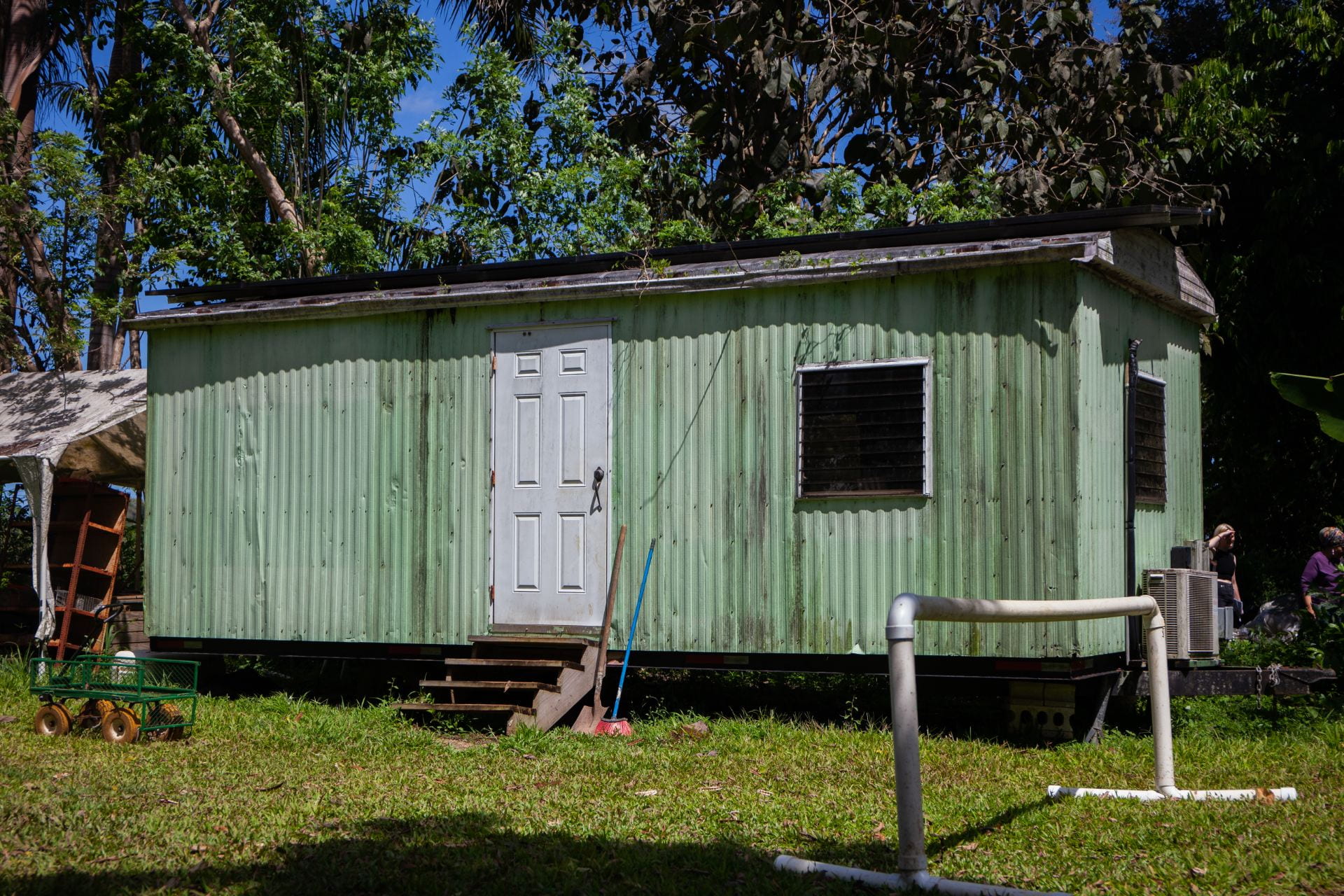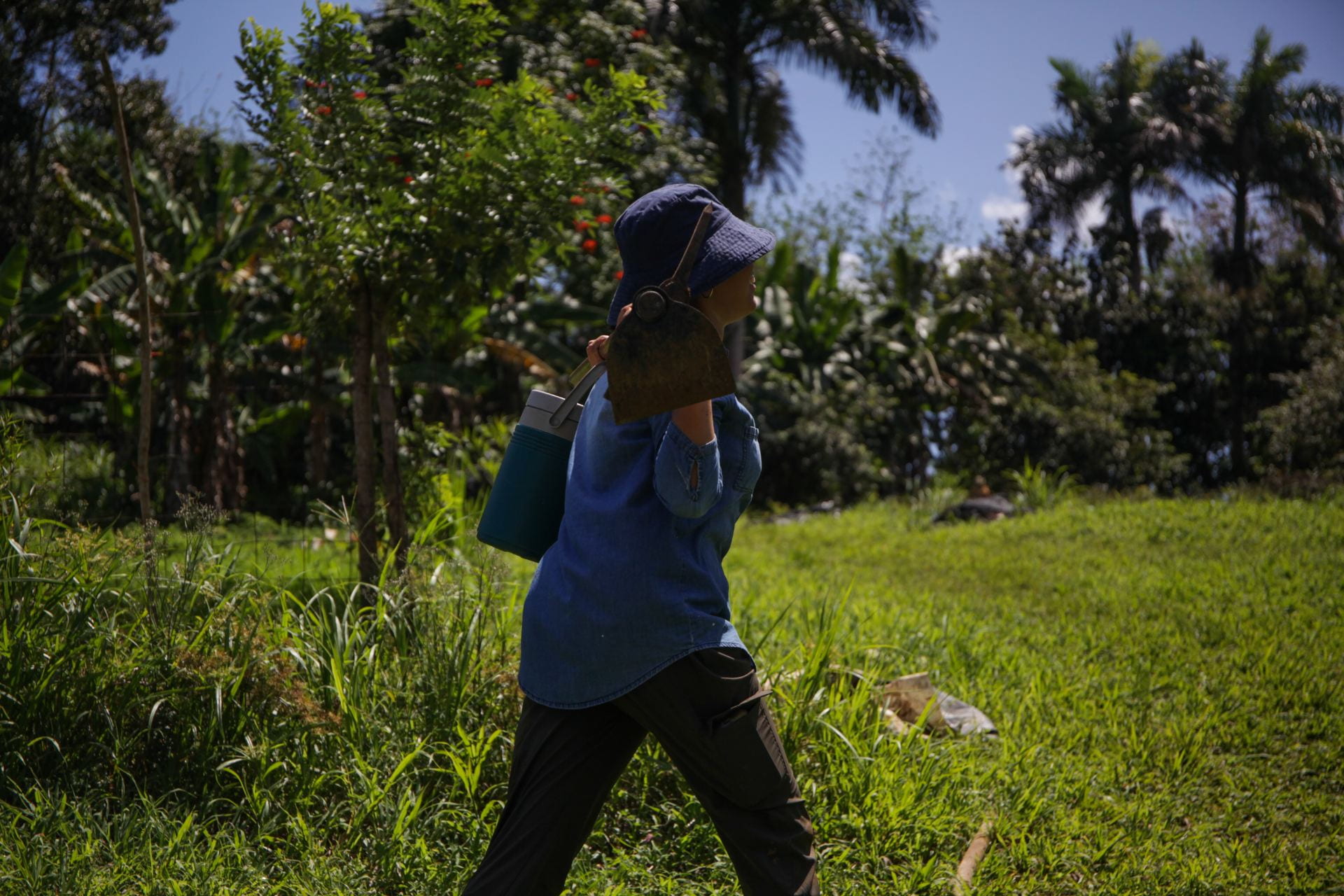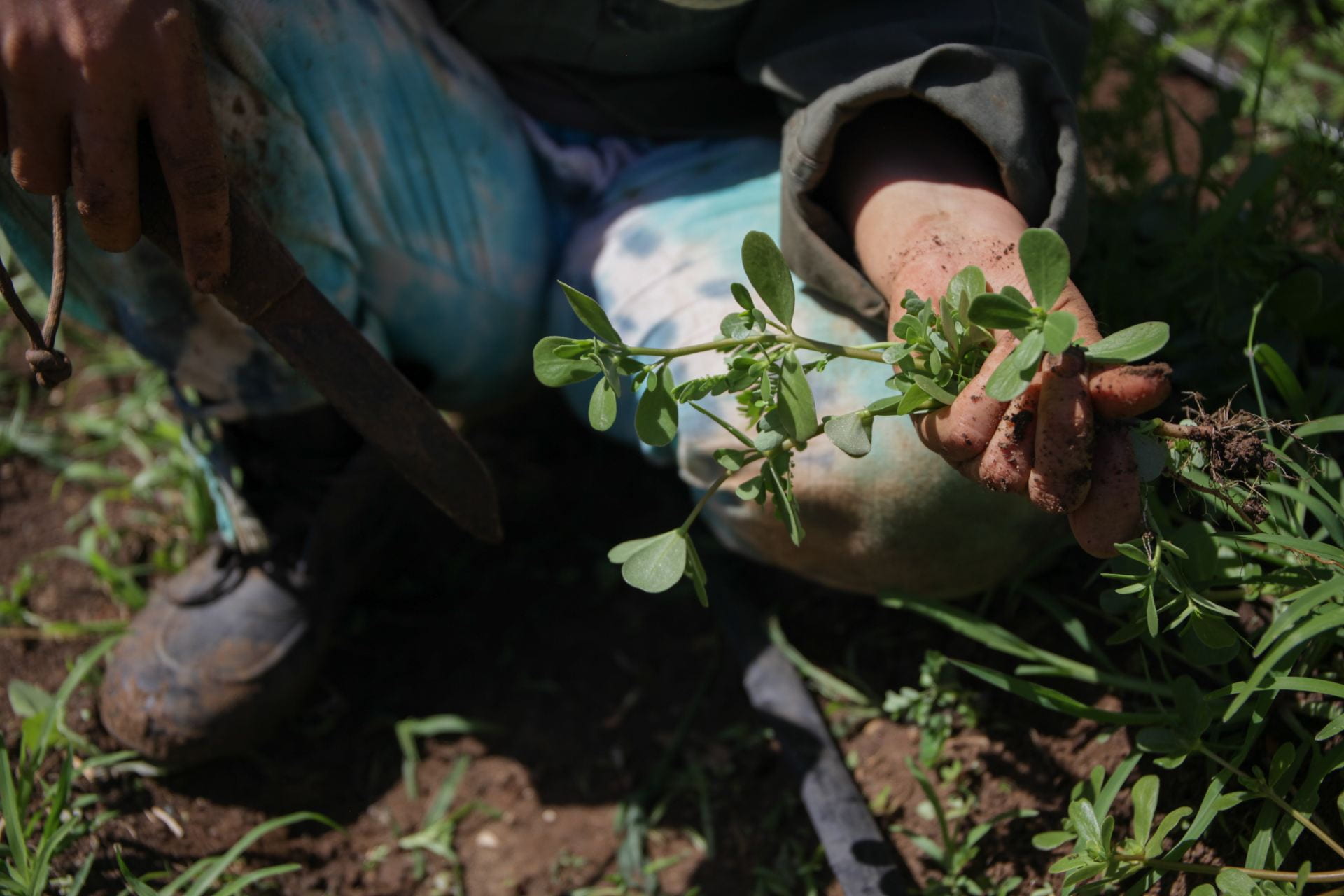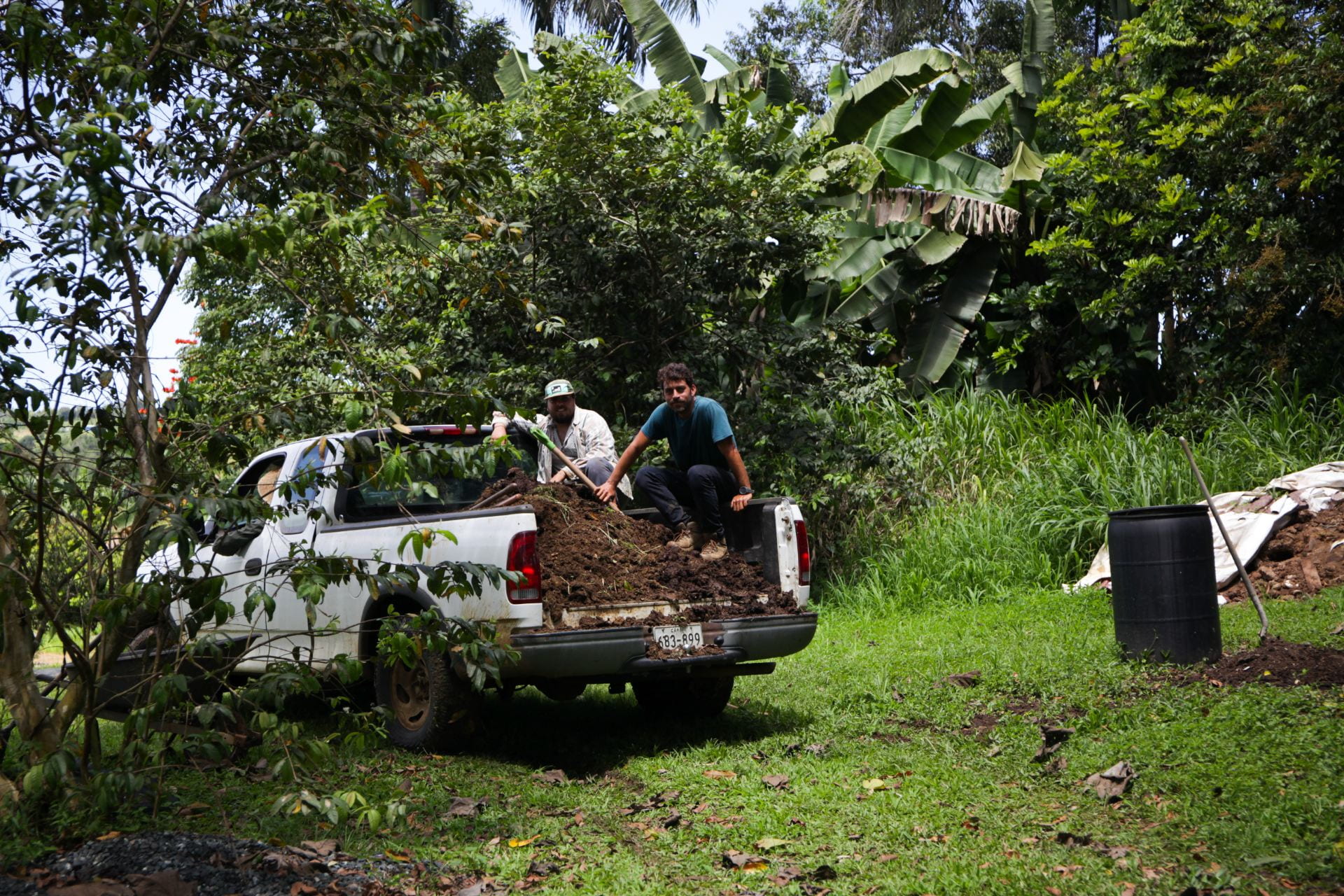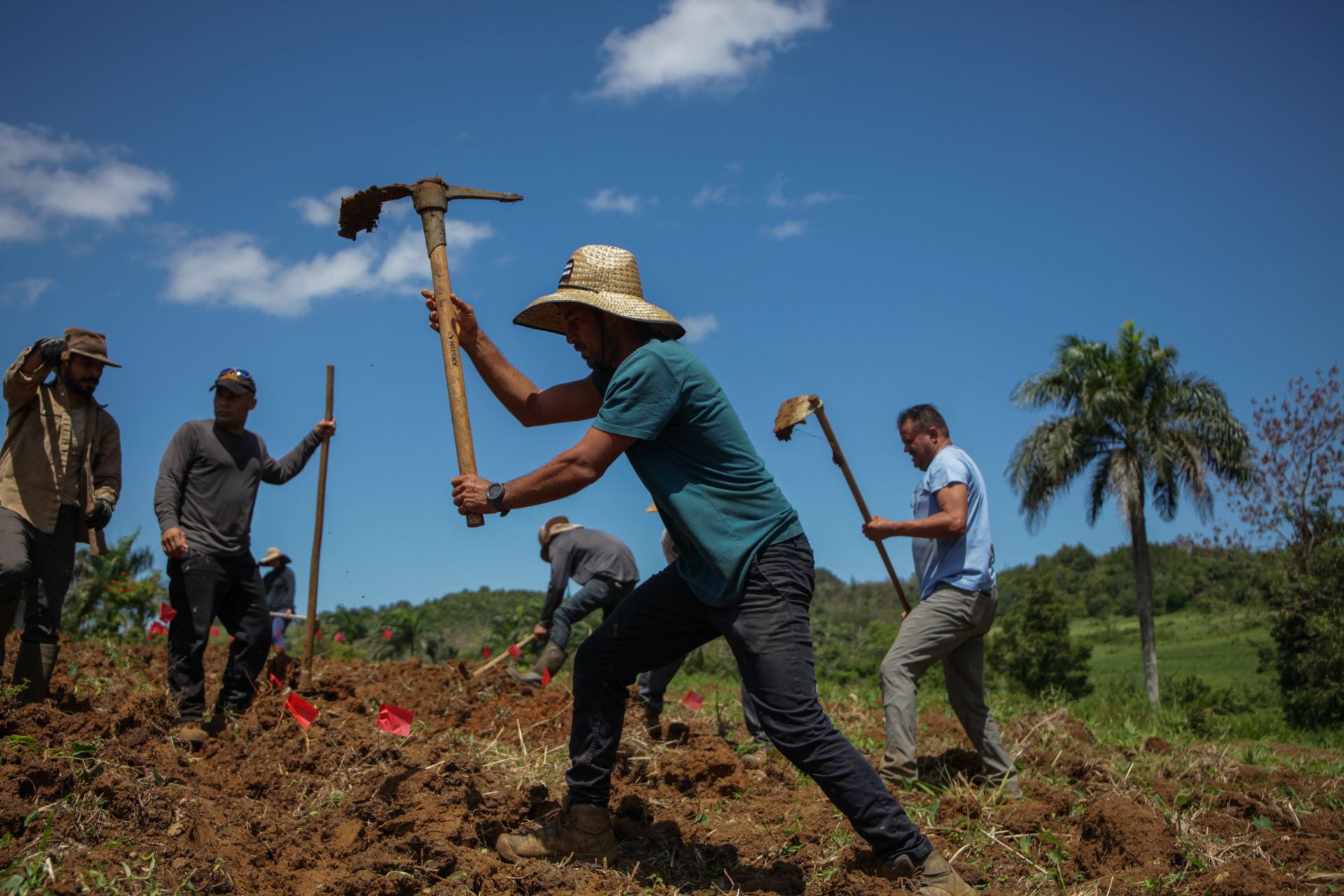
Photo by Crystal Herrera | Students at the El Josco Bravo Agroecological Project prepare a plot for planting.
By Ariana Bennett
TOA ALTA, Puerto Rico — On four acres of farmland in Toa Alta, a quick 30-minute drive south of the metropolitan bustle of San Juan, four different varieties of cabbage grow in quiet resistance. Nestled in a rolling bed of rich, composted soil, the cabbage heads lift and fall with the contours of the land, replicating an ancestral irrigation practice to prevent soil run-off. The land cradling the cabbage has seen centuries of exploitation, first under Spanish colonialism, followed by U.S. imperialism, and finally to this day, as Puerto Rico suffers a lack of control over its land as an unincorporated territory of the United States.
These particular cabbages are an experiment. Each of the four varieties of seeds originates from the mainland, where the climate is colder and dryer. The archipelago’s long history of exploitation has created a nutritional dependence on the United States. Seeds, the majority of which are imported from non-tropical regions, must be adapted to the Puerto Rican heat and sun. In Toa Alta, students from El Josco Bravo, a Puerto Rican practical agroecological education and activism project, search for the strongest seeds to propagate in the hopes of establishing a viable food source for the surrounding local community.
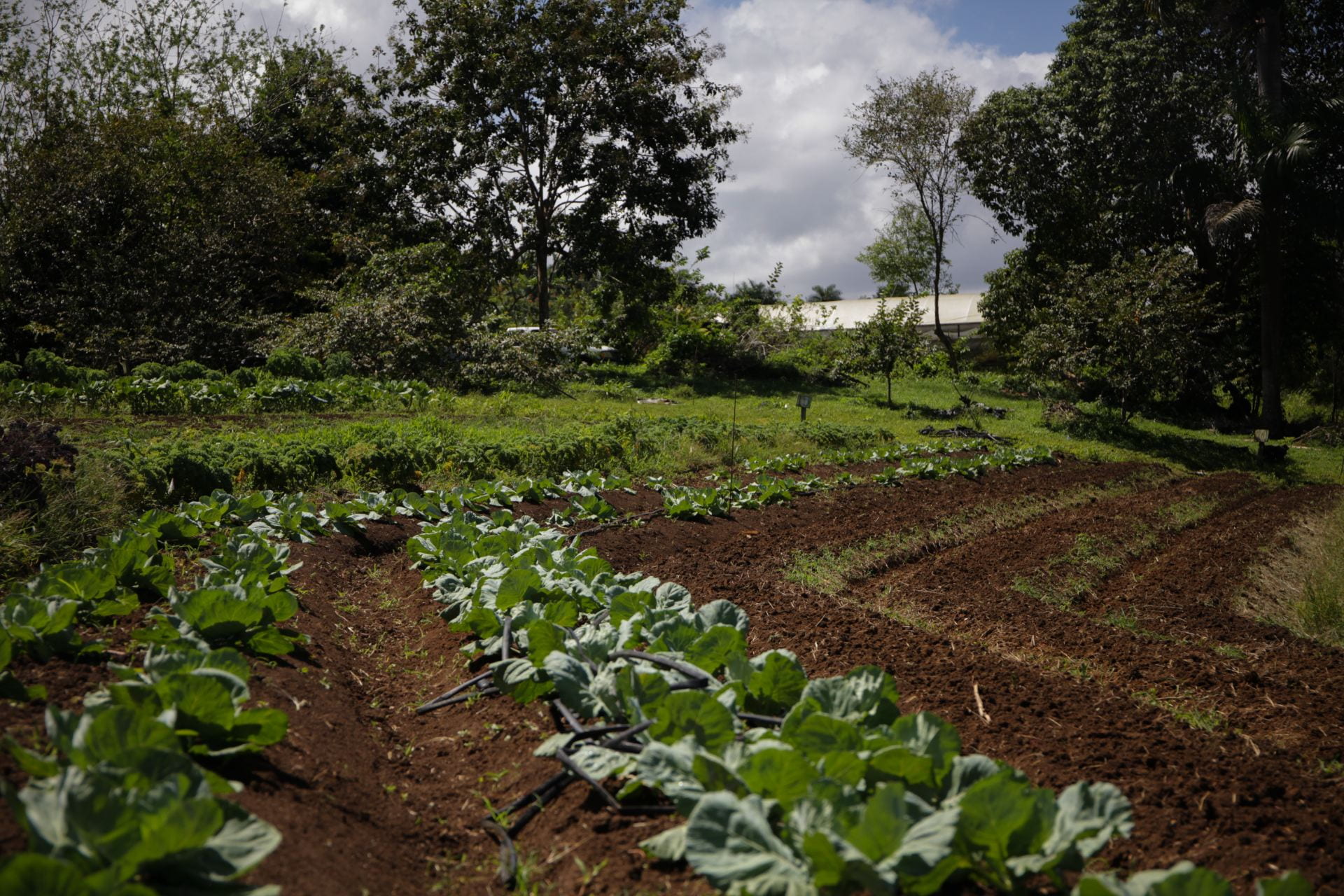
Photo by Crystal Herrera | The El Josco Bravo project.
Every year from January until May, El Josco Bravo welcomes around 150 Puerto Rican students to one of their seven locations across the territory where they will farm using the principles of “agroecology,” which marries ecological prudence with agricultural production principles to work the land sustainably. This practice stands in contention with the exploitative practices of industrial agriculture that dominate the south of Puerto Rico’s main island.
On a sunny Friday in March, Suley Cruz, 32, a former student who now farms at El Josco Bravo full-time, stands in the shade surveying 30 students as they clear the project’s educational plot. Cruz, with a background in natural medicine, had always considered farming, even while studying in university. After the devastation of Hurricane Maria, which destroyed 80 percent of Puerto Rico’s farmland in 2017, Cruz remembers bare grocery store shelves and a feeling of dread. “After Maria, is when I said, like, ‘Oh my god, this is real. We don’t have food here,’” she said. “‘We don’t have gas. We don’t have anything.’” Shortly after, Cruz left her life as a massage therapist and began volunteering at El Josco Bravo, seeking certainty about where her food was coming from.
Without congressional representation, Puerto Rico is unable to recovery from a decades-old set of policies that encouraged monocrop agriculture and rapid industrialization and instituted shipping restrictions. These policies wrest control over one of life’s basic necessities out of the hands of locals and into the hands of Washington politicians. While food independence is impossible as locals rely on foods, such as rice, that are not produced en masse on the archipelago, the territory has the capacity to produce nearly 40 percent of its local consumption, according to Myrna Comas Pagán, former secretary of Puerto Rico’s Department of Agriculture.
Today, only 10 percent of the population’s food supply is produced on the island, but locals are trying to alter that equation. Beginning 10 years ago, independent agriculture projects boomed as Puerto Ricans began to worry about what was on their plate. These projects are creating an independent food system on the island in a step toward food sovereignty – the control over food production, distribution and policy by those who produce, distribute and consume the food itself.
At the heart of these efforts is the want to provide fresh, nutritious food in a step toward reducing dependence on commercial food systems that do not serve local communities. Those in favor of communal agriculture such as farmers’ markets and educational projects like El Josco Bravo believe that food security is more than finding a desired product at the supermarket; it is the collective control over who will cultivate the archipelago’s food and how.
“By definition, food sovereignty includes that the people of a certain country have control over the food production. That’s not our case,” said Crystal Díaz, co-founder of Produce!, a delivery app constructing an autonomous food system on the island. “Obviously most of us want to reach food sovereignty, but we do have a political constraint.”
In Toa Alta, the students and farmers at El Josco Bravo are just one piece of the movement to assert autonomy over Puerto Rico’s food system and bring the territory’s food culture back home. Cruz smiles at the students walking uphill toward the shade, seeking relief from a hot morning spent tilling the land by hand. Plucking the hat from her head, she absentmindedly picks at the dirt underneath her fingernails. As Ian Pagán Roig, the project’s co-founder, passes by, Cruz turns to talk with him about the day’s work. Then, with her hands on her hips, she flashes a bright smile and gestures toward a sunlit carrot patch where she had been working all morning.
Photos by Crystal Herrera | (In order) Suley Cruz, full-time farmer at the El Josco Bravo project; Cruz poses with Ian Pagán Roig, the co-founder of El Josco Bravo; Holding her hat, Cruz’s hands are covered in dirt after harvesting all morning.
“There was nothing here,” Cruz said, her dark brown hair pulled into a low messy bun revealing the tanned face of a full-time farmer. “Now, with our practice, and our discipline, and our will power, we have this project,” she said. “Seeing 30 people that don’t know how to hold a machete, cleaning a plot, farming…It’s beautiful. It’s powerful and revolutionary.”
Where it all began
In December of 1898, after the end of the Spanish-American war, Puerto Rico was ceded to the mainland United States which, for nearly 50 years, encouraged the sugarcane, tobacco and coffee industries. Together, U.S. agribusinesses and local sugar mill owners transformed the archipelago into a monocultural plantation economy, and many farmers became wage workers. By 1945, capitalist agriculture had become pervasive on the territory, and by 1956 manufacturing-generated income outpaced agricultural income for the first time.
In the 1940s, Puerto Rico’s first elected governor, Luis Muñoz Marín, implemented a series of development policies, known as Operation Bootstrap, with the aim to diversify the economy through rapid industrialization. The proposals relied on U.S. investment and used tax exemptions to encourage American corporations to build factories on the territory. In just 20 years, Puerto Rico’s economic dependence shifted from agriculture to industry, and the population became increasingly urban. In 2019, just 1 percent of the labor force was employed in agriculture. Sparse agricultural employment has precipitated a need for migrant farm laborers, largely from surrounding Caribbean countries.
The decline of local agriculture was hastened by the 1920 Jones Act, a U.S. policy that requires all vessels carrying cargo domestically to be U.S. built, owned and crewed primarily by U.S. citizens. As a captive market, Puerto Rico is therefore unable to compete fairly with neighboring countries with similar climates, production cycles and lower wages, according to Pagán. In 2019, the act was estimated to cost Puerto Rico’s food and beverage sector $367 million yearly.
Only four Jones Act carriers serve Puerto Rico and each have their own shipping terminals, located south of Old San Juan on Isla Grande. The four companies – Crowley, Tote, Luis Ayala Colon and Trailer Bridge – dominate the land around the San Juan Bay, according to José Francisco Nazario, senior director of Terminal Operations and Administration at Crowley Maritime. The land is leased from the Port Authority, the government authority responsible for the main maritime entrance points on the territory.
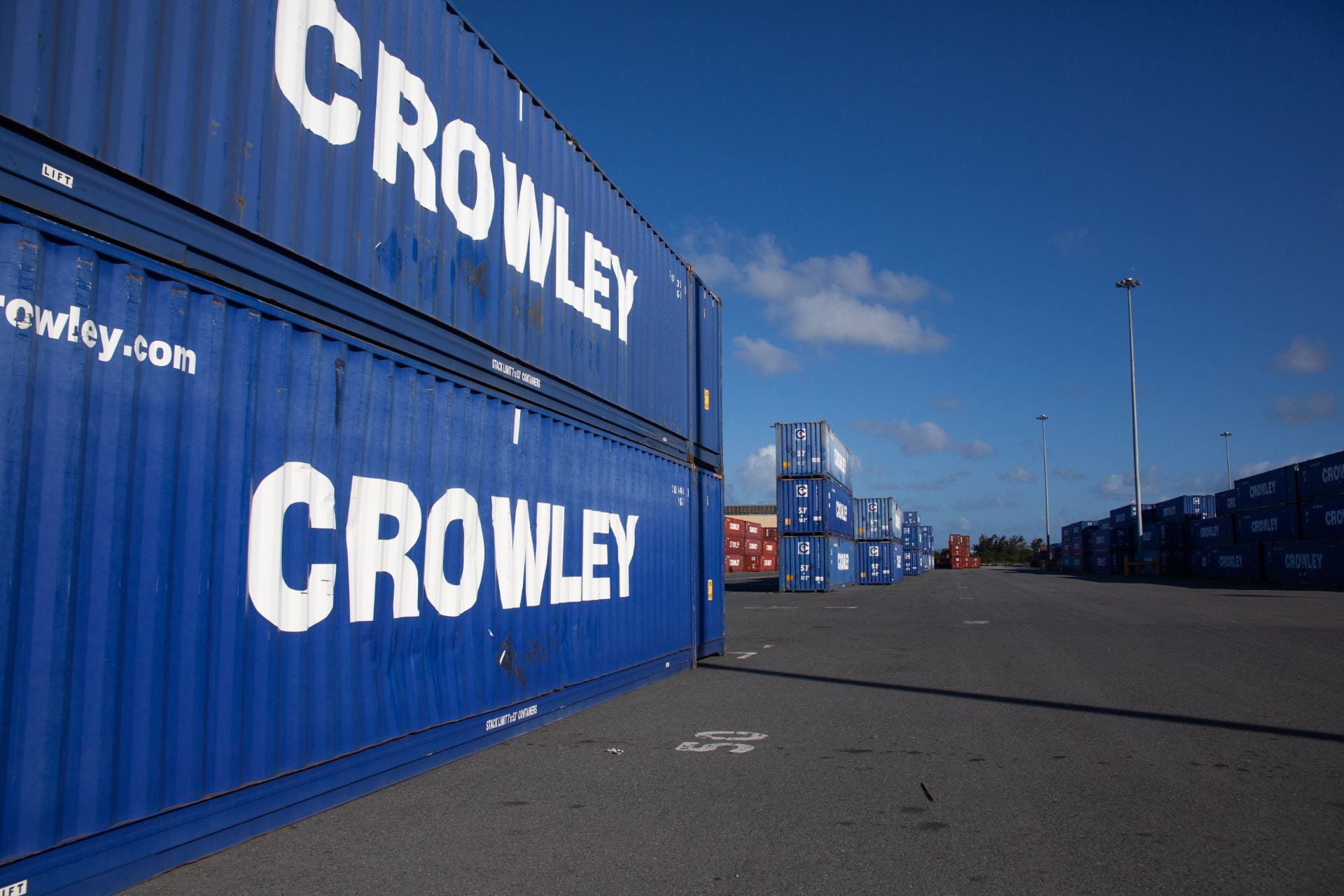
Photo by Elisabeth Hadjis | Empty shipping containers at Crowley’s terminal on Isla Grande.
Using two new vessels constructed in 2018 and 2019 with the capacity of over 800 containers each, Crowley services Puerto Rico from Jacksonville, Florida, twice a week on Mondays and Fridays. The trip takes 56 hours, but Crowley’s customers, the largest of which are department stores, pharmaceutical companies and car dealers, take notice if the shipment is late. “The vessel is supposed to be here Monday at 7 a.m. in the morning. If we fail four, five hours, which is nothing when you are talking about sea transportation, we get some calls,” Nazario said. Puerto Rico depends on the maritime industry for everything, he added.
Puerto Rico’s import dependence is compounded by inadequate local food policy. “Puerto Rico doesn’t have a food policy that works around food security,” Díaz said. “There is a lack of political will to put in place food policy that works for everyone in the food system, not only the big companies but also small- and medium-sized food producers and value-added stages.”
Increased local production has the potential to revitalize Puerto Rico’s economy. Every 1 percent of agricultural imports that are converted to locally sourced products adds an estimated $72 million to the economy, Díaz said. However, agricultural production data on the territory is 3 years old, she added, which fails to measure the economic impact of food. Studies often only measure agricultural production on farms themselves, ignoring the added value of food manufacturing.
“We don’t have a culture on food,” Díaz added. “That means we are not measuring, economically, the impact that food has in our country, even when we have to eat at least three times a day.”
Supermarkets have become the convenient option for Puerto Ricans looking for a one-stop-shop food source. “If we want to do something that’s super local, you need to make it as, or more, convenient than the supermarket. Because if not, it’s not going to work,” Díaz emphasized. Supermarkets allocate their limited shelf space among the products and companies that can afford to be there, regardless of local origin, nutritional value, social responsibility or cultural importance. Over the past 20 years, they have essentially become real-estate businesses, she added.
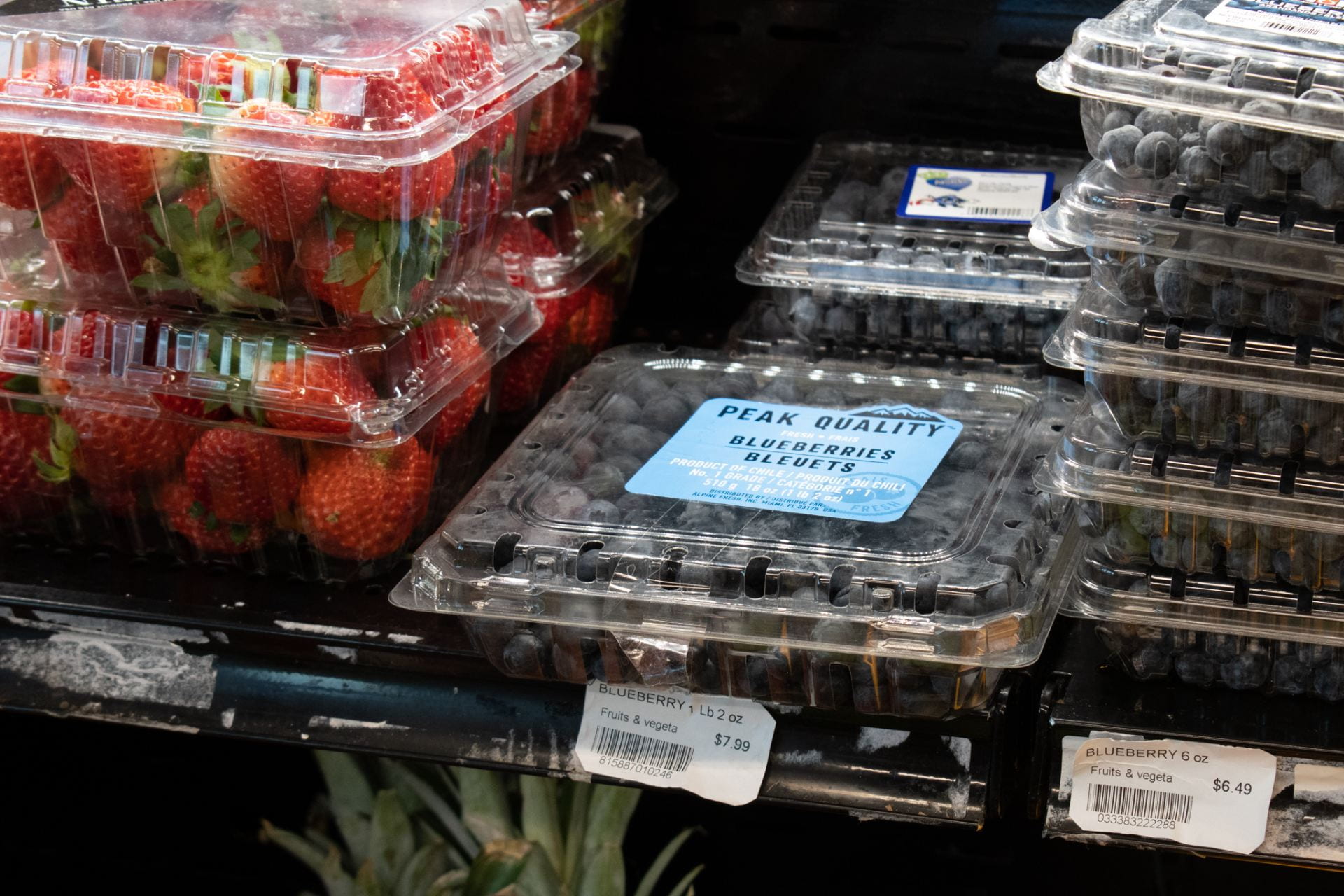
Photo by Amanda LaRiviere | Imported blueberries at a supermarket in Old San Juan.
Yet, there is a food and crop abundance on the island that is not recognized within commercial spheres or the restaurant industry, said Tara Rodríguez, co-founder of El Departamento de la Comida, a non-profit collective based in San Juan supporting small-scale, local food projects on the archipelago. “All of our industrial food system is based on import-export in a way that is not prioritizing local consumption and local systems,” they said. “In places like a colony, like Puerto Rico, the psychological effects of capitalism and colonialism have brought us to a point where we aren’t giving the value to all of the abundance around us.”
In the way of the land
Puerto Rican farmland is some of the best land in the world for agriculture. The island boasts different types of soil throughout, from mountainous terrain used for coffee production in the center of the island to rich coastal lands producing vegetables in the south. “They are the best lands for farming vegetables. But the thing is, a big part of them, mostly, is rented to multinationals, like Monsanto, Bayer,” Cruz explained. These agribusinesses practice extractive agriculture, which stands in contention with El Josco Bravo’s agroecological philosophy. “They are taking out, taking out, taking out all the time,” she added.
According to the 2017 USDA Census of Agriculture, Puerto Rico has 8,230 farms totaling over 487, 775 cuerdas, a traditional unit of measurement approximately equal to an acre. A long history of import dependence, natural disasters and economic instability have led to a decrease in farmland on the archipelago. From 2012 to 2018, the number of farms in Puerto Rico decreased by 37.5 percent, or 4,929 farms. The total amount of farmland, however, decreased by only 16.6 percent, resulting in an increase in size of 33.3 percent per farm.
By law, Puerto Rico reserves land for agriculture, called reservas agrícolas. The Land Authority, the agency responsible for renting the majority of the farmland owned by the government, requires a development plan from farmers and determines the land best suited for the proposed project. In 2020, the authority managed 85,797.72 cuerdas of the available farmland, of which 5,439.89 remained left to be allocated.
It is difficult, said Licia Garcia, a food anthropologist, for agroecological projects to receive land from the government. Besides the capital already necessary to start a farm, prospective farmers need connections and time to write papers and documents to obtain permits. “A small farmer in Puerto Rico would never have been able to do a project without some sort of support, economically,” said Ana Elisa Pérez Quintero, the co-founder of La Colmena Cimarrona, an agroecological organization based on the island of Vieques, a 52-mile landmass off the east coast of the Puerto Rican mainland. Many small farmers in Puerto Rico choose to get loans and end up in debt, she added.
La Colmena Cimarrona waited nearly a year for its leasing proposal to be approved after its plot of land lay idle for 30 years. In the end, the organization was leased 20 acres at $750 a month. Due to lack of funding and staff, they use only 4 and a half.
The organization’s 3-acre, 2-year-old farm, La Semillera, is leased from the Land Administration, another government land management agency. As opposed to the Land Authority, the Land Administration is more expensive and allows residential and commercial projects, Pérez Quintero said. The farm plants food varieties that are culturally relevant and resistant to both drought and climate change, including sweet potato, herbs such as lemongrass and cilantro, eggplant and peppers, all with seeds sourced largely from other local farmers.
“It was important for us to have this piece of land because it’s a way that we feel we’re saving this land from other kinds of development,” she said. “Having land leased that is government and that is for a community project is instrumental in the work that we do.”
The island, which is dependent on an hour-long ferry for transport to the mainland, is a microcosm of Puerto Rico’s food deficit. “We get the leftovers of whatever the main island gets, which is already sort of left over,” Pérez Quintero said. “So it’s normal to walk into a supermarket here and to not have fresh vegetables at all, even dairy or meat.” Twice a month the farmers of the Colectiva Agrícola Viequense, of which La Colmena Cimarrona is a member, sell their produce at a local farmer’s market, La Sambumbia. Often, it is the only produce locals can find to eat.
Back on the main island, El Josco Bravo operates on 69 acres leased from the Land Authority. Despite the project’s efforts, negotiations with the agency to decrease their property size were fruitless, and while they pay rent for the full acreage, it only produces on 4 to 6 of those acres.
Recently, after El Josco Bravo constructed a shelter on the land for shade and class meetings, the Land Authority increased their monthly rent by $50, justified under agrotourism. “They really think that we are gaining money from the school which is not true because the school is by donation,” Cruz explained. “The purpose of the school is to create more farmers, and we want to be accessible to everybody.”
Photos by Crystal Herrera (in order) | El Josco Bravo students carry their tools back from the educational plot, The schoolhouse of El Josco Bravo.
The important thing to them is that the project pays the rent, Cruz emphasized. “These people in the administration, in the office over there, in San Juan city, they are completely disconnected from the reality of the farmers in the lands of Puerto Rico,” she said. So much so that between hurricanes Irma and Maria, a letter from the Land Authority arrived demanding payment under threat of land seizure.
People who want to work the land should own their land, argued Cruz. In two years, El Josco Bravo’s contract with the Land Authority expires. “It doesn’t feel right. We have been 10 years, nine years, working this land, and at the end of the agreement of the rental, we have nothing,” Cruz said. If the contract is not renewed, “we lose our livelihood and 10 years of life here.”
There is a new generation of young people looking to agriculture, “but the challenge is how they can acquire land and what capital they have to develop this land,” Pagán said. Following the passing of Act 22 last September, purchasing land on the archipelago became even more difficult for Puerto Ricans. This policy provides a total tax exemption on passive income for their mainland counterparts once an individual becomes a resident of the territory, encouraging investment and reducing land supply.
Both La Colmena Cimarrona and El Josco Bravo would like to buy their plots of land. “We wish to buy it, it’s just very expensive, and in theory, they don’t sell it,” Pérez Quintero said.
This highlights the lack of control over not only Puerto Ricans’ food, but the land on which it is grown. “It’s super easy for them [mainland residents] to come here and buy land and establish hotels on the best lands because those are the ones that they are selling,” Garcia said. “And we who want to cultivate and grow, we can’t because we don’t have the funds.”
Comer local es comer bonito
For Puerto Rican agriculturists, unfriendly soil is a fact of life.
Photos by Crystal Herrera (in order) | A student farmer carries her tools toward the shade; a farmer at El Josco Bravo picks weeds; student farmers move compost down to the educational plot to enrich the soil.
Some, like Díaz, see irony in trying to achieve food sovereignty in an unincorporated territory. “I don’t like to use the term sovereignty,” she said. “Sovereignty in Puerto Rico is highly politically charged because of the colony status. So I prefer, myself, to use the term food security.”
For Garcia, to eat is the most political act of all. The food grown on agroecological farms is a movement toward decolonization. “We are used to eating a specific type of flavor, and that flavor comes from the outside because we import 85 percent of our food,” she said. “Once you understand the other possibilities the food has, you understand your culture, you understand what you’re doing, you understand the story of it and you can also share it.”
Each project on the archipelago is unique in the way it looks and functions. “Food can be everywhere here. It could be on the side of the street in a city. It could be the lemon tree in your auntie’s backyard. You could grow food on your balcony,” Rodríguez said. “You could be somebody that just harvests in a different fashion.”
The midday sun burns bright over El Josco Bravo, a welcome relief from a rainy spring season that has delayed their planting schedule. In the shade underneath a Puerto Rican flag, Cruz dreams of a mosaic of agricultural farming projects throughout the island. “We dream to have our own land, to have security of land,” she said. “It’s not human, this feeling of working the land for other people. It’s contrary to food sovereignty.”
Her bright teal work pants, tucked carefully into her work boots, are covered in dirt on the knees. Her hair has fallen out of its bun and onto the shoulders of her olive green work jacket. The embroidered Proyecto Agroecológico, El Josco Bravo on the lapel peaks out from beneath strands of hair.
She crosses her legs and leans forward. “We farm as a revolution. We farm because we believe in a better future.”
Some, like Díaz, see irony in trying to achieve food sovereignty in an unincorporated territory. “I don’t like to use the term sovereignty,” she said. “Sovereignty in Puerto Rico is highly politically charged because of the colony status. So I prefer, myself, to use the term food security.”
For Garcia, to eat is the most political act of all. The food grown on agroecological farms is a movement toward decolonization. “We are used to eating a specific type of flavor, and that flavor comes from the outside because we import 85 percent of our food,” she said. “Once you understand the other possibilities the food has, you understand your culture, you understand what you’re doing, you understand the story of it and you can also share it.”
Each project on the archipelago is unique in the way it looks and functions. “Food can be everywhere here. It could be on the side of the street in a city. It could be the lemon tree in your auntie’s backyard. You could grow food on your balcony,” Rodríguez said. “You could be somebody that just harvests in a different fashion.”
The midday sun burns bright over El Josco Bravo, a welcome relief from a rainy spring season that has delayed their planting schedule. In the shade underneath a Puerto Rican flag, Cruz dreams of a mosaic of agricultural farming projects throughout the island. “We dream to have our own land, to have security of land,” she said. “It’s not human, this feeling of working the land for other people. It’s contrary to food sovereignty.”
Her bright teal work pants, tucked carefully into her work boots, are covered in dirt on the knees. Her hair has fallen out of its bun and onto the shoulders of her olive green work jacket. On the lapel, Proyecto Agroecológico, El Josco Bravo, embroidered in yellow, peeks out from beneath strands of hair.
She crosses her legs and leans forward. “We farm as a revolution. We farm because we believe in a better future.”
